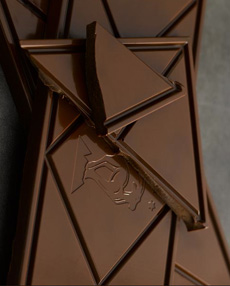TIP OF THE DAY: Tips For Storing Chocolate
|
If you only occasionally bake with chocolate, it’s easy to end up with leftover blocks and bars. How long can you keep the chocolate? Dark chocolate can last for two years or more. Milk chocolate and white chocolate should be kept for under a year, because the milk content in them deteriorates. |

Beyond the expiration date on the package: You can extend the shelf life of chocolate with proper storage. Photo courtesy Artisan Chocolate Company. |
|
|
What Are Those White Spots? It’s called bloom. Room temperatures in excess of 75°F, fluctuations in temperature (from cold to warm, e.g.), and too much humidity can cause the chocolate to develop bloom—a white-grey streaking or spotting on the surface. There are two types of bloom. Fat bloom is the appearance of large cocoa butter crystals on the chocolate surface. It is a result of improper storage, poor tempering, lack of tempering or changes in temperature. Heat-related issues cause the cocoa butter to separate and rise to the surface. While the chocolate looks dull, it tastes the same and is safe to eat. It can still be used for baking or recipes in which the chocolate is melted (the cocoa butter reincorporates into the chocolate when melted). For other uses, such as candy-making, the chocolate needs to be re-tempered. Sugar bloom is more problematic. It is a crystallization of sugar that can be caused by high humidity and condensation (and is why you shouldn’t store chocolate in the fridge). The moisture combines with the sugar in the chocolate to create a “syrup.” When the syrup evaporates, large sugar crystals remain on the surface of the chocolate. The grainy sugar bloom crystals make the chocolate unpleasant to eat. But as with fat bloom, bars with sugar bloom can be re-melted and re-tempered, or used in baking or in sauces where the texture is not a factor. Filled chocolates with sugar bloom cannot be restored. Filled chocolates with fat bloom will still taste fine, although they won’t look as appealing. Fat bloom and sugar bloom can look the same. To determine which you have, you’ve got to touch them. Fat bloom fees oily and melts to the touch, while sugar bloom feels grainy. What If You Have Too Much Chocolate? Chocolate bars (“eating chocolate”) can be used for baking, and baking chocolate can be used for eating. To substitute conventional chocolate bars for baking chocolate, you need to use the percent cacao specified in the recipe (40%, 70%, 85%, etc.) or else adjust the recipe’s amount of added sugar to compensate. Nuts in chocolate bars will go rancid over time, so especially observe those expiration dates. If the expiration date was a few months ago, take a bite. It may be just fine. Or it may be ready to be turned into hot chocolate or barbecue sauce. Chocolate Fun
|
||


